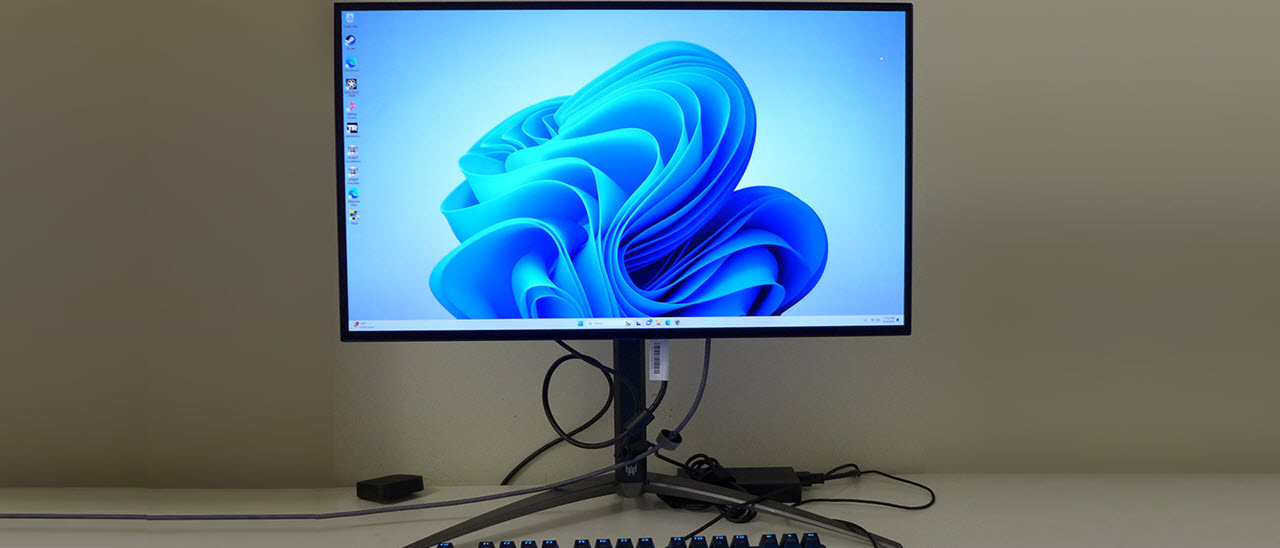Why you can trust Tom's Hardware
Grayscale and Gamma Tracking
Our grayscale and gamma tests use Calman calibration software from Portrait Displays. We describe our grayscale and gamma tests in detail here.
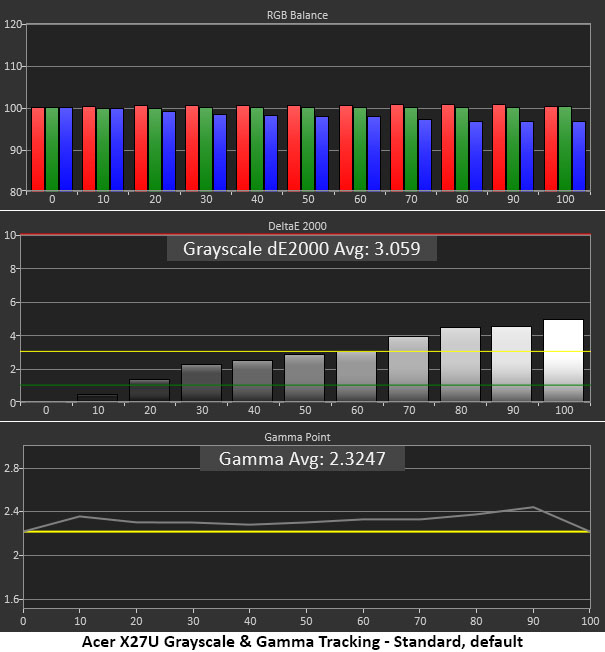
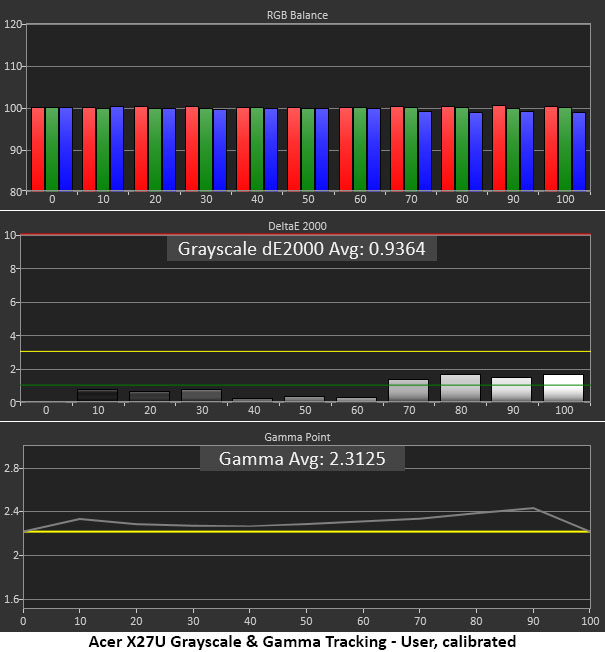

The X27U starts in its Standard picture mode, and it is right on the edge of needing calibration. I would say it does and others might say it doesn’t. The warmth indicated in the first chart manifests in brightness steps above 60%, so if you’re looking for it, you’ll see it. And if you’ve read this, you might be unable to unsee it. Gamma is a tad dark, closer to 2.3 or perhaps the BT.1886 standard. But my color tests indicate the X27U is a power gamma monitor.
Calibration removes all visible grayscale errors. I only had to adjust the gain sliders; the bias controls are unchanged. Gamma is a tiny bit lighter, but visually, there is no difference. When contrast is this high, dark gamma is forgivable. And if you want it lighter, that option is available in the Color menu.
Comparisons
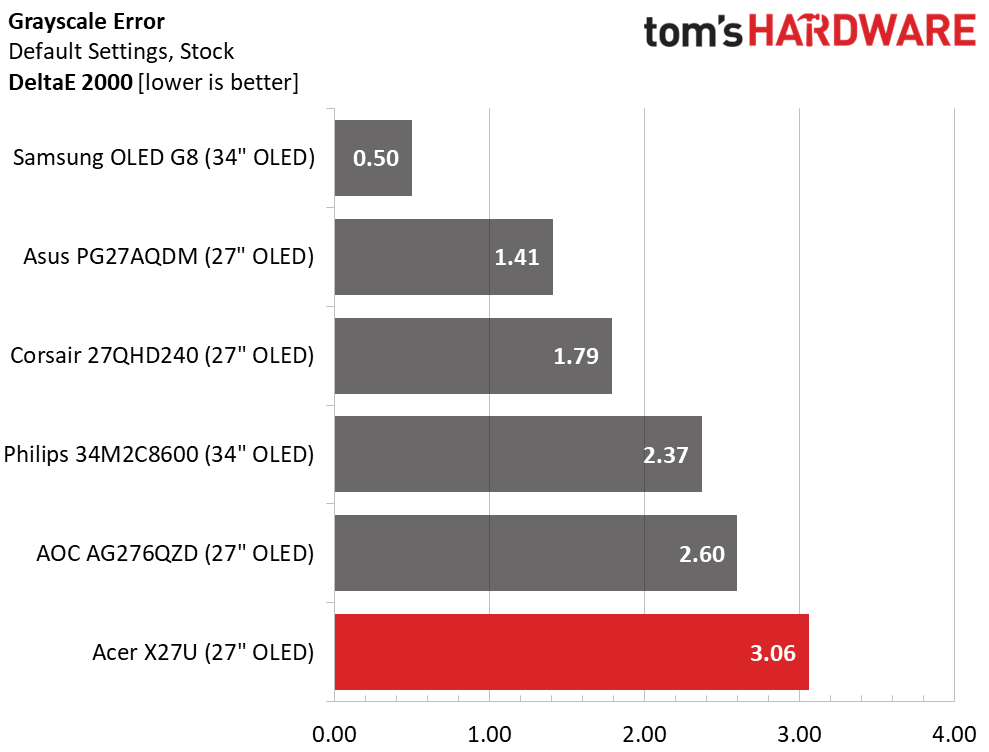
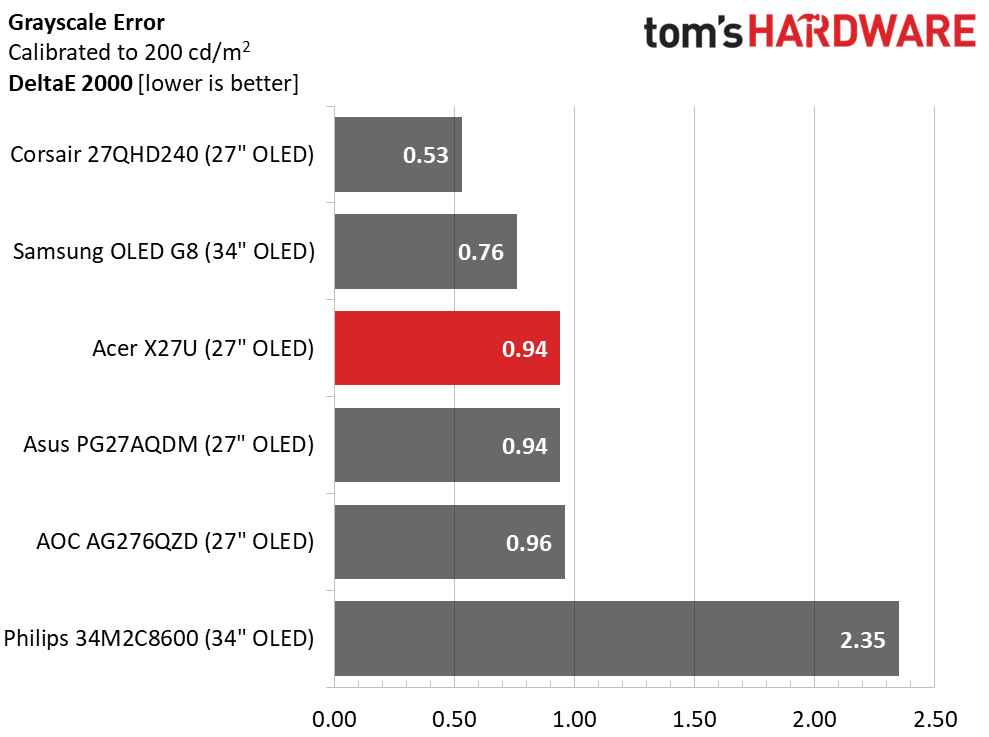
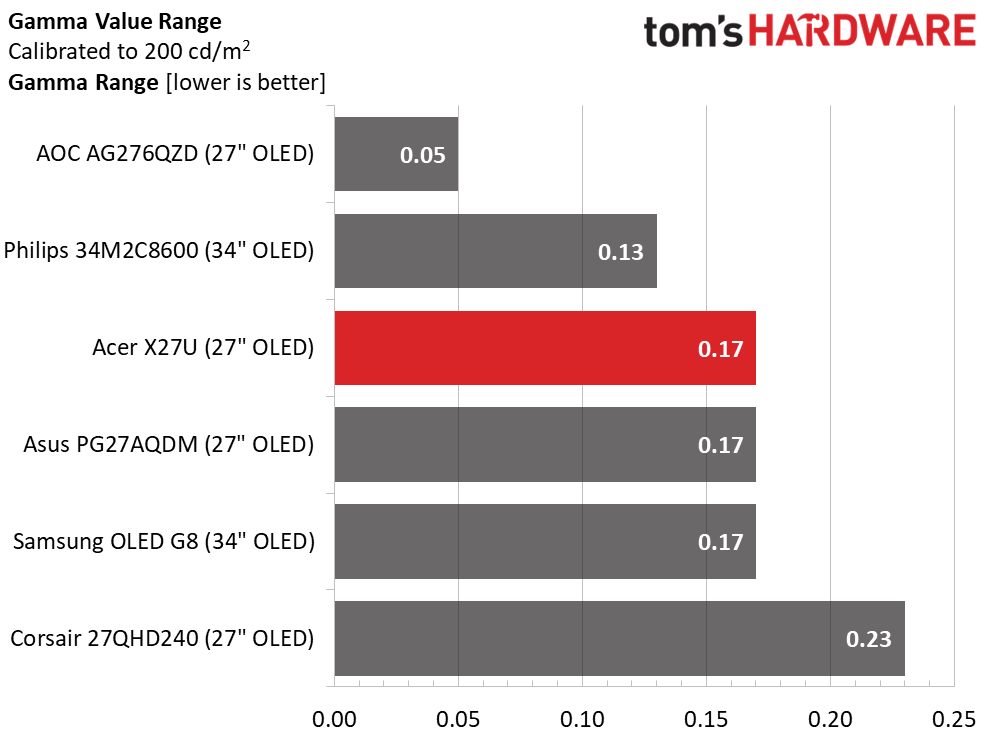
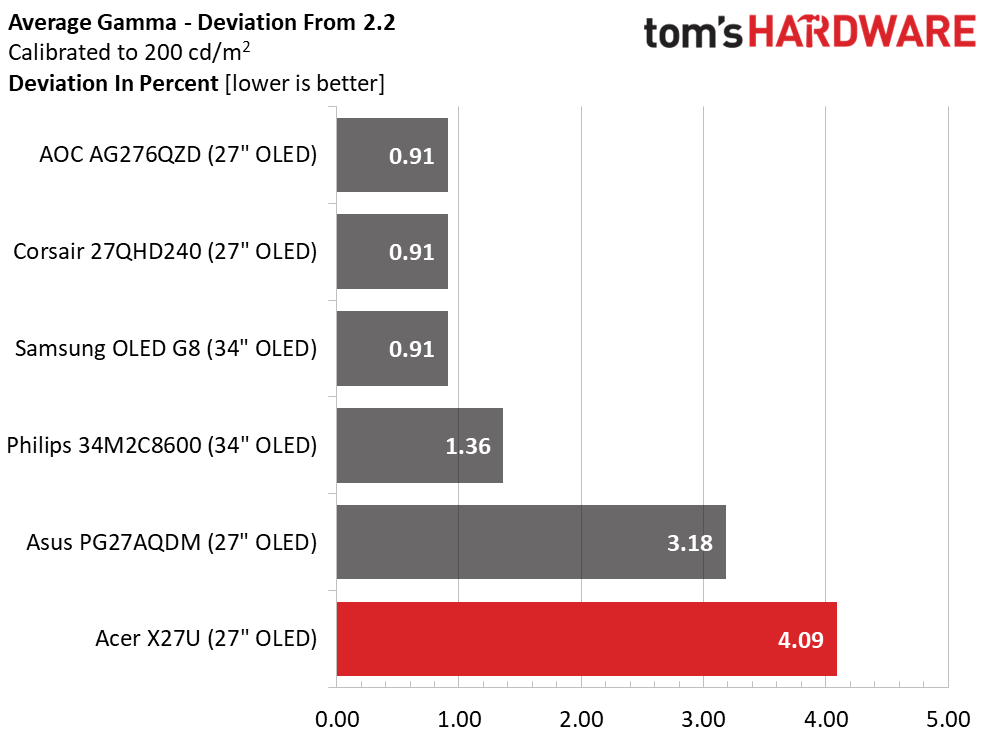
A premium monitor like the X27U should be on-point out of the box, and it nearly is. It’s possible that other samples would measure better than mine, but I’m being very picky here. 3.06dE is nothing to complain about. Thanks to the precise controls, reducing the error to 0.94dE is something to be happy about.
Gamma tracking is tight with just a 0.17 range of values, which is about average for the group. The deviation of 4.09% equates to an actual value of 2.31. It's a bit out of spec but forgivably so. I’d rather the gamma be too dark than too light.
The sRGB mode is fixed with no option for calibration. Grayscale tracks a bit warm, and gamma is relatively close to the 2.2 reference with slightly dark values at 60% and above. This is acceptable for a gaming monitor but with a few more adjustment options, it could be a pro screen.
Color Gamut Accuracy
Our color gamut and volume testing use Portrait Displays’ Calman software. For details on our color gamut testing and volume calculations, click here.
Get Tom's Hardware's best news and in-depth reviews, straight to your inbox.
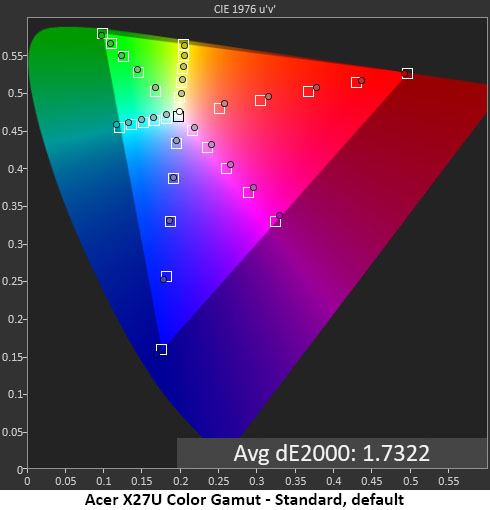
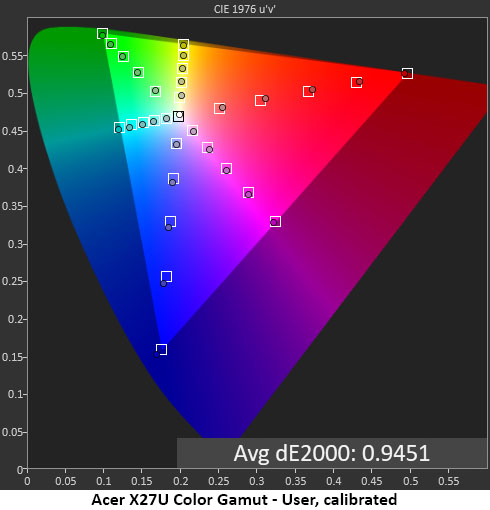
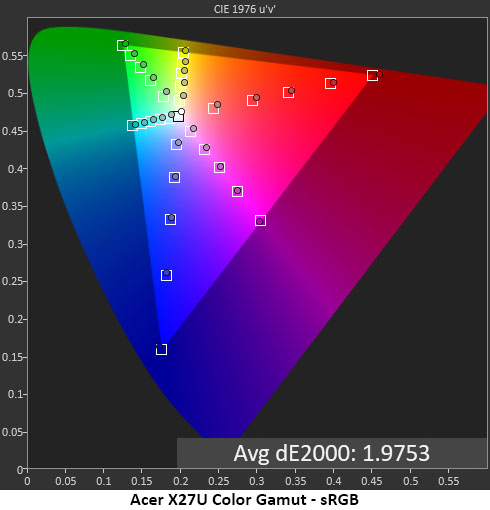
The X27U has a huge color gamut with near-100% coverage of DCI-P3 and it hits every target with a 1.73dE average error. This is superlative performance. Calibration takes the error down to just 0.95dE which is a really good thing. There are few monitors that can get under 1dE in my gamut test.
The sRGB gamut is also very accurate, with no visible errors and an average of 1.98dE. The lack of calibration options hasn’t affected gamut accuracy, but it would be nice if one could dial in the grayscale tracking. This is a minor flaw.
Comparisons

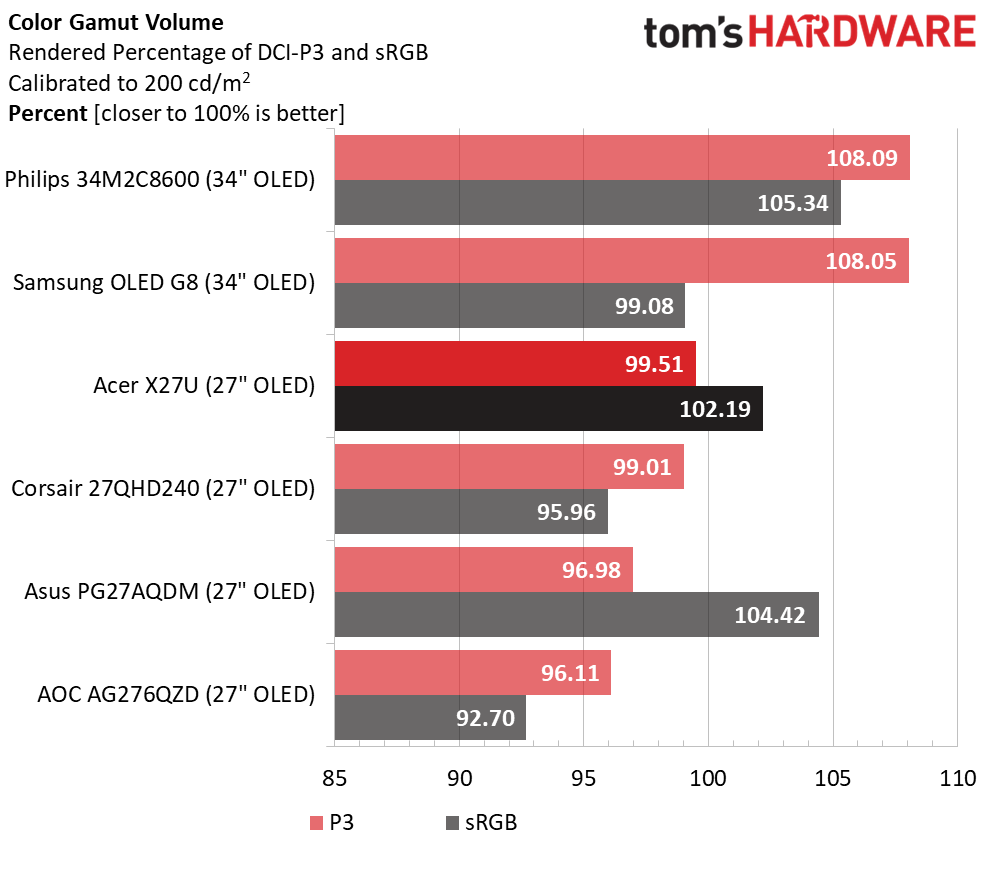
The X27U’s color gamut score of 0.95dE is one of the lowest I’ve ever recorded. Many pro monitors can’t achieve this. This is in reference to DCI-P3. The sRGB score is very good at 1.98dE so it can be used for color-critical applications if you can forgive the slightly warm grayscale tracking. As you can see, there isn’t a bad OLED in the bunch. They all have excellent color accuracy.
They also all have excellent color volume. For LCDs, the average is around 92% but clearly, OLEDs are a more colorful technology. And a Quantum Dot layer is not a prerequisite. The Philips and Samsung screens have them, so their gamuts are a bit larger. But 99.51% coverage is nothing to complain about. The X27U is extremely colorful and hits full saturation for every color. It also covers all of sRGB with a tiny bit of bonus red.
Test Takeaway: Between the X27U’s wide and accurate color gamut, and its high contrast, there are few, if any, monitors that are more colorful. It isn’t quite as accurate as others before calibration but once adjusted, it rises to the top. The picture is stunning in every respect.
MORE: Best Gaming Monitors
MORE: How We Test PC Monitors
MORE: How to Buy a PC Monitor
MORE: How to Choose the Best HDR Monitor
Current page: Grayscale, Gamma and Color
Prev Page Brightness and Contrast Next Page HDR Performance
Christian Eberle is a Contributing Editor for Tom's Hardware US. He's a veteran reviewer of A/V equipment, specializing in monitors. Christian began his obsession with tech when he built his first PC in 1991, a 286 running DOS 3.0 at a blazing 12MHz. In 2006, he undertook training from the Imaging Science Foundation in video calibration and testing and thus started a passion for precise imaging that persists to this day. He is also a professional musician with a degree from the New England Conservatory as a classical bassoonist which he used to good effect as a performer with the West Point Army Band from 1987 to 2013. He enjoys watching movies and listening to high-end audio in his custom-built home theater and can be seen riding trails near his home on a race-ready ICE VTX recumbent trike. Christian enjoys the endless summer in Florida where he lives with his wife and Chihuahua and plays with orchestras around the state.
-
gg83 Thank you so much for this review and calibration recommendation! I bought this monitor a few months ago. I have been using amd adrenaline to adjust color hue and whatnot. I have it set per game so maybe I won't have to do that anymore.Reply -
Perosteck I can't see that this has G-Sync anywhere on the product specs online, or on the Asus website. Is this correct?Reply -
Order 66 um, anyone notice how it says DisplayHDR 400 certification when the measured HDR brightness is 600 nits? does that seem strange to anyone else? I'm also confused on why this monitor has two different HDR certifications. If it has HDR 10 and can reach 1000 nits, then why only DisplayHDR400?Reply -
parkerthon So… I scrolled this article which is brimming with praise, but nothing about burn in for people that run windows for productivity all day? I understand it’s a flaw of all oled but it’s still worth calling out. Asus has no burn-in protection apparently. Also it’s woled so text clarity presumably sucks. Will continue to wait patiently for a technological miracle that solves these two issues I guess. Also hdr support for games is still awful. At ~$700 for a 27” monitor you’d ideally use ONLY for gaming on a few select titles that really embrace hdr… bit much. Really hoping mini-led eventually comes along. I don’t need pure blacks, just something that’s not a gray white glow.Reply -
UnforcedERROR Reply
Mini-LED already exists in monitors (this article even notes the alternative version was prior to this OLED), and they're appreciably cheaper in most cases. The AOC Q27G3XMN and KTC M27T20/Cooler Master GP27Q are all decent. The AOC isn't even $300, and the KTC can be about $330 if you find a coupon. HDR is good for movies too, but I'd never recommend a monitor for that over a good TV.parkerthon said:Really hoping mini-led eventually comes along. I don’t need pure blacks, just something that’s not a gray white glow.
You're misunderstanding the certifications. HDR10 is a static metadata certification mainly used in film and TV. It can be mastered up to 4,000 nits, but largely aims for 1,000. A TV/monitor doesn't have to hit 1,000 nits to get HDR10 certified, and most content isn't mastered that bright anyway. Presumably HDR600 should be applicable here, but I suppose they decided to play it safe. HDR400/600/1000 is a VESA standard for monitors, unlike HDR10 which is more about decoding the HDR10 signal.Order 66 said:um, anyone notice how it says DisplayHDR 400 certification when the measured HDR brightness is 600 nits? does that seem strange to anyone else? I'm also confused on why this monitor has two different HDR certifications. If it has HDR 10 and can reach 1000 nits, then why only DisplayHDR400?
Also OLEDs are notably less bright than mini-LED. Some newer models can hit a peak brightness of over 1,000 nits in highlight tests, but full screen brightness is often far less. As an example, the Sony A95L has a peak highlight of 1,350 nits. A TCL QM8? 2,500, and in some cases read up to 3,000+. Peak brightness on that A95L is like 300 nits though, so it's all relative. -
Order 66 Reply
I have this monitor and it’s great. It gets extremely bright. If I wasn’t so concerned about OLED burn in, I would’ve gotten the x27uUnforcedERROR said:The AOC Q27G3XMN -
UnforcedERROR Reply
Yup! I went the same route for the same reasons. Micro-LED is probably going to be the best option once it scales down, but that's a few years out still.Order 66 said:I have this monitor and it’s great. It gets extremely bright. If I wasn’t so concerned about OLED burn in, I would’ve gotten the x27u -
icycool Christian, I am not reading your reviews anymore.Reply
You fail to be up front about the panel used. QD-OLED is vastly different from WOLED.
You never mention text clarity. Something people actually care about.
See TFTCentral on how to do a proper monitor review.
